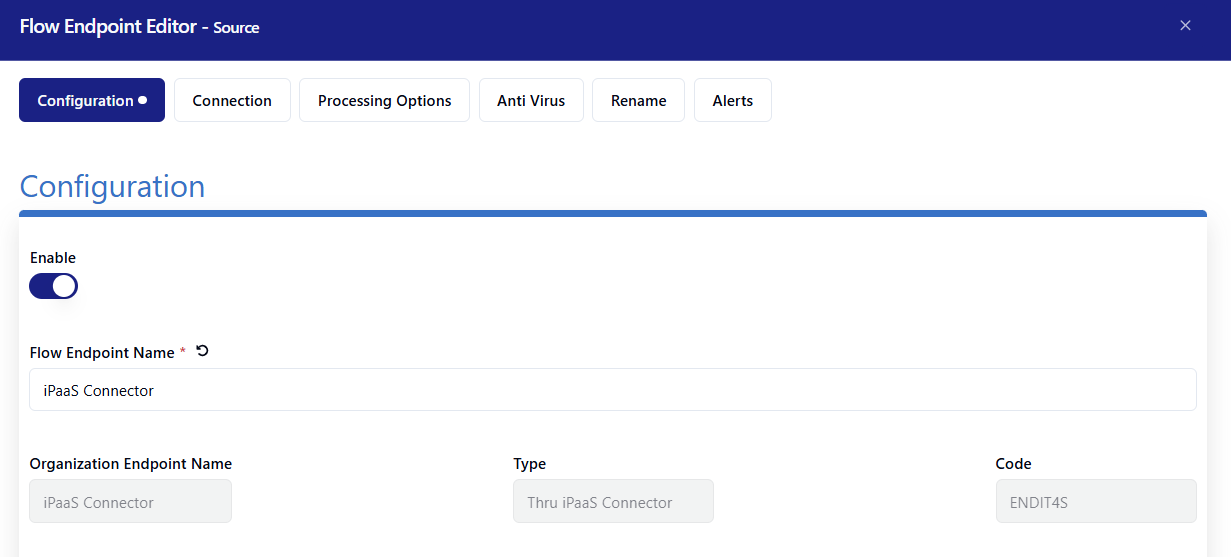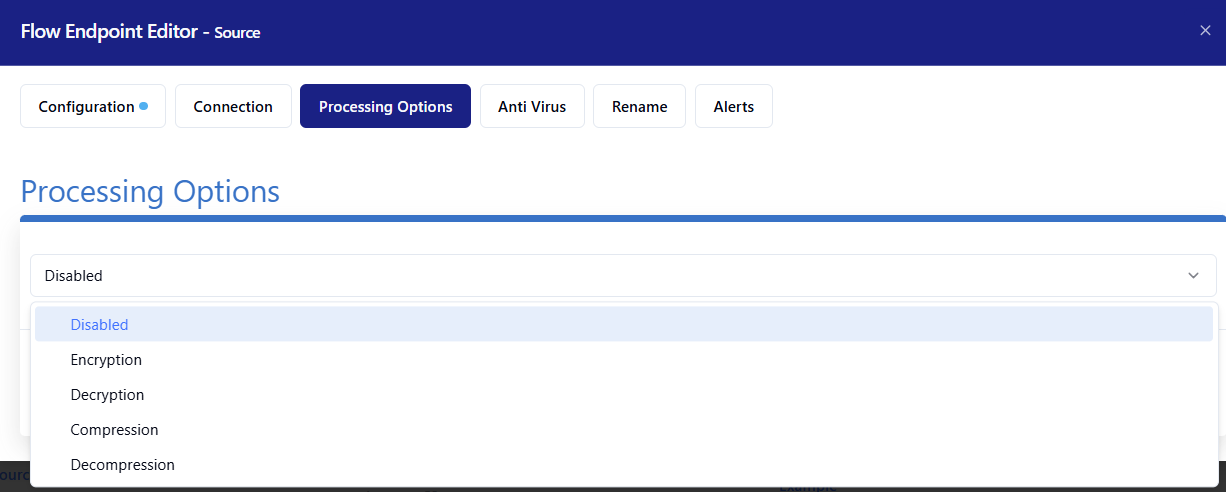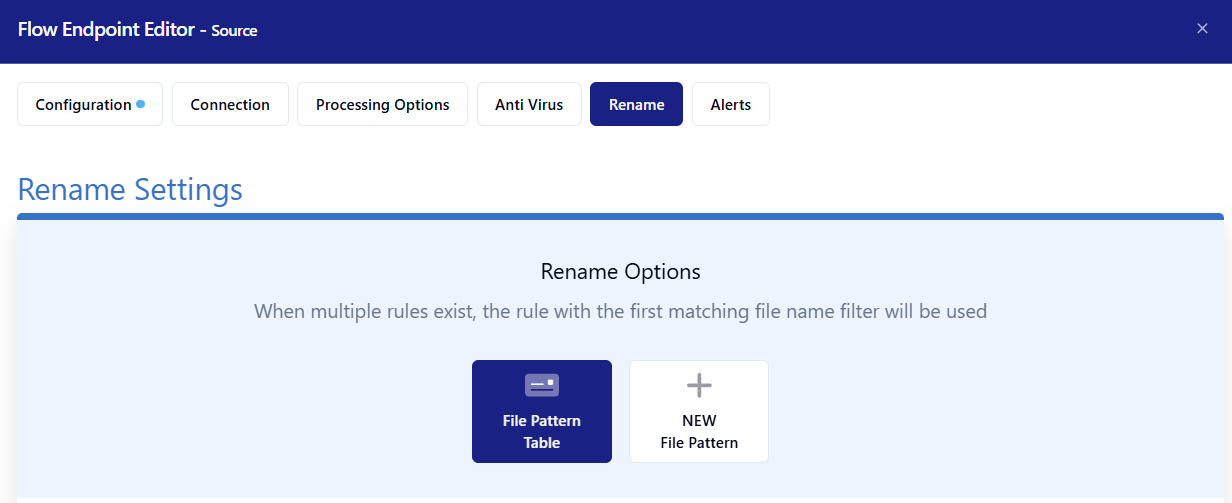Flow Endpoint Editor - Source - iPaaS Connector
In Flow Studio, you will encounter two boxes: Source and Target. On the blue Sources box located on the left side of the page, click the Actions icon adjacent to your iPaaS Connector endpoint. From the options presented, select Edit Flow Endpoint Settings.

1. In the Configuration tab, enter a Flow Endpoint Name *.

2. If you want, configure Filename Filters by specifying if files should be Include(d) and/or Exclude(d) from the pull. You can only use Regular Expressions here.

3. In the Note field, add notes to help you keep track of your endpoint and settings.
4. Click the Save button to save the changes and go back to Flow Studio.
2. Click the Actions icon next to your iPaaS Connector endpoint. Select Edit Flow Endpoint Settings. Click the Connection tab.

Each iPaaS Connector endpoint has 1 secret key per organization. Connection provides API Url, Storage Repository, Site Key, and Secret Key. You need this information to successfully create an MFT Connector in MuleSoft or in Boomi.
This information must be entered in your MFT connector configuration. If you regenerated the key, you must update the connector.
The secret key may be regenerated on the endpoint configuration page. It can be regenerated by clicking the link, clicking the Regenerate button on the endpoint configuration page.
Click the Save button to save the changes and go back to Flow Studio.
3. Click the Actions icon next to your iPaaS Connector endpoint. Select Edit Flow Endpoint Settings. Click the Processing Options tab.

Encrypt/decrypt or compress/decompress files. Please note that encryption and compression can’t be enabled at the same time.
To encrypt or decrypt files with PGP:
1. Toggle Encryption or Decryption on.
2. Select a PGP key to use.
All your organization’s PGP keys will be listed here. If a PGP key is missing or no keys are listed, go back to the Organizations – PGP Keys section and add a PGP key.
3. Click Use Selected.
4. Click the Save button to save the changes and go back to Flow Studio.
To compress or decompress files:
1. Toggle Compression or Decompression on.
2. In the Select a Compression Type box, click the Select a Compression Type drop-down and select your compression type: Zip, Zip7 or Gzip.
3. Under the field Archive Password (Optional), you can set a password. Use the eye icon to check your password.
4. Click the Save button to save the changes and go back to Flow Studio.
4. Click the Actions icon next to your iPaaS Connector endpoint. Select Edit Flow Endpoint Settings. Click the Rename tab.

Renaming files can be particularly beneficial when you have multiple similar files being directed to the same Organizational Endpoint. This process allows you to effortlessly incorporate a timestamp into each file, enhancing organization and clarity.
Multiple File Rename Patterns can be created and processed per endpoint.
To set up a new file pattern:
1. Click NEW File Pattern.
2. Enter a unique Rule Name *.
3. Enter a value to filter or enter .* to allow all files in the Rename Files Matching * field.
4. Enter a Test String, which is the text you want to replace.
5. In the New Pattern field, drag and drop common rename building blocks to create a rename structure. The Result field will show what the new file would be.
6. Click the Apply on paths block to activate renaming on that path. Some endpoint types support multiple source or target paths.
7. Click the Save button to save the changes and go back to Flow Studio.
Regex Selector Example
The incoming Test String is being filtered by the Regex Selector to pull out the word public.


5. Click the Actions icon next to your iPaaS Connector endpoint. Select Edit Flow Endpoint Settings. Click the Alerts tab.

Use alerts to be notified of Transfer Inactivity, Transfer Limit Exceeded, Transfer Success or Transfer Error. Add an email address to receive alerts from the Add/Edit Email pane. Once enabled, added email addresses will start receiving emails for the selected notification types. There’s no limit on how many emails can be added to receive alerts for the endpoint.
Set global email alert configurations to send alerts to multiple email addresses about the same errors. After email addresses are added, they can be administered on the Alert Table.
The character limit per email is restricted to 200.
To set up email alerts:
1. Click Add/Edit Email.
2. Enter an email address in the Email * field.
3. Click the checkbox for what you’d like to be alerted about. Non-global confirmation options include the addition of Transfer Success and Transfer Error.
4. Click the Save button to save the changes and go back to Flow Studio.

Global Configuration is applied to all email addresses within the Alert Table.
Transfer Inactivity defines the time period to trigger an alert if no file transfers have occurred.
Transfer Limit Exceeded triggers an alert if the defined number of files is exceeded with the set time period.
6. Click the light blue View and Push Changes button.
